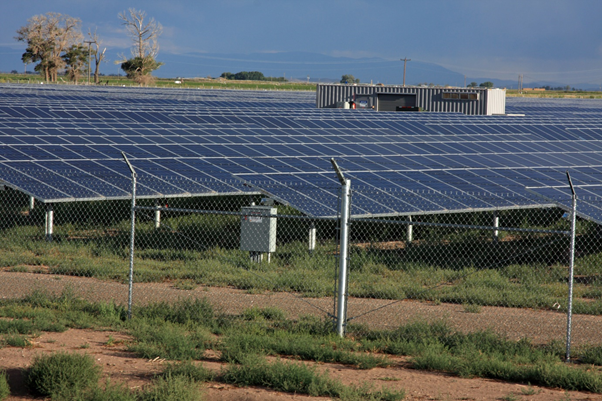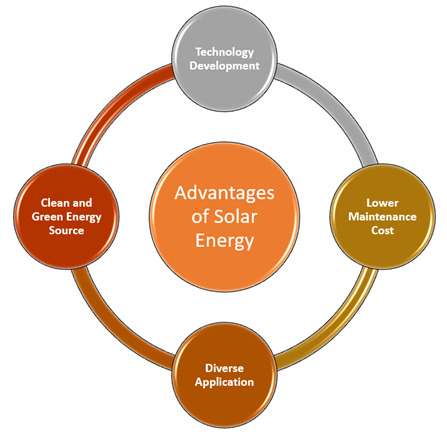What is Solar Energy?
Solar Energy is a form of renewable energy derived from the Sun and is then converted into thermal or electrical energy. Solar energy is the cleanest form of energy that is available in an abundant quantity. The sunrays are converted into the usable form using many evolving technologies like photovoltaic cells, solar heating equipment, molten salt power plant, solar thermal energy and artificial photosynthesis. The sunrays carry up to 173,000 terawatts of energy on Earth which is around 10,000 times the global energy demand.

Source: © Lovelyday12 | Megapixl.com
Why does Sun radiate energy?
The Sun is the leading star in the solar system that transfers constant energy in the form of radiation. Sun is mainly primarily made up of hydrogen and helium atoms. Due to higher density and temperature at the centre of the Sun, the hydrogen nuclei undergo nuclear fusion. As a result of this, two hydrogen nuclei join together to form a helium nucleus. A significant amount of heat is released in the form of radiation during the process, generating huge energy. This produced energy radiates out of the solar surface. The research and estimates show that the Sun has enough hydrogen in its core to last for another 4.5 billion years.
How can Solar energy be harnessed?
There are two primary ways to harness solar energy into a usable form. The technologies involved in harnessing solar energy are Photovoltaics and Solar Thermal. Let us discuss both the technologies briefly:

Source: © Twwphoto | Megapixl.com
Photovoltaics: Photovoltaics is a technology that has the capability to convert solar energy into electric energy directly. During the conversion process, photons of light are absorbed by the semiconductors, which releases electrons and, in turn, form electricity.
Solar panels fitted with semiconductors are installed in buildings and solar farms, which are capable of generating an enormous amount of electricity. The electric energy generated by this process can be used directly after a generation or stored in batteries. Solar panels convert solar energy into electric energy with the help of the photovoltaic effect. The rays strike on the solar cells made up of silicon, allowing electrons and electricity generation. The current generated by this process is a direct current that can further be fed into a solar inverter to convert it into an alternating current.
Solar Thermal Technology: Solar Thermal is the second way of converting solar energy into a usable form. The heat energy captured from the Sun's radiations is used for various applications. Few examples of solar thermal applications are stated below:
- Solar Heater: Thermal collectors are used in this process to convert sunlight into heat energy. The heat captured by the thermal collectors is then transferred to the running water through a piping system. It is the best alternative to conventional fossil-fuel-powered water heaters.
- Solar Electricity: Another method for generating electricity is to convert Sun's radiation into electric energy with the help of photovoltaic cells. This method involves the use of solar thermal power plants. These plants incorporate special liquid-filled tubes that have the capability to store the heat energy of the Sun. The heated liquid can generate steam by heating water or any other liquid that can produce steam. The steam is used to rotate the turbine and generate electricity.
- Passive Solar: Passive solar technology doesn't utilise any external equipment. Instead, they use the local climate to maintain the temperature of buildings. The windows, walls, floors of the building are designed to collect or reflect the Sun's heat energy during summers and winters.
Summary
- Solar Energy is a form of renewable energy derived from the Sun and converted into thermal or electrical energy.
- Hydrogen and helium are the two main constituents of the Sun, which are present in 71 per cent and 27 per cent, respectively.
- Photovoltaics and Solar Thermal are the two main technologies used to harness solar energy in a usable form.
Frequently Asked Questions (FAQs):
What are the advantages of Solar Energy?
There are various advantages of solar energy. Let us discuss some of the most important advantages briefly:

Copyright © 2021 Kalkine Media Pty Ltd
- Technology Development: The constant advancement in the solar power sector can increase the efficiency of solar panels that can multiply the electrical input of solar power systems.
- Lower Maintenance Cost: Solar energy system has a relatively lower maintenance cost than other renewable energy sources. Most solar panels come with a warranty period of 20-25 years and require very little maintenance.
- Diverse Application: Solar energy has a wide range of applications ranging from generating electricity to heating purposes. The installation of solar panels can fulfil the energy demands in homes and industries too.
- Clean and Green Energy Source: Solar energy is a clean and green energy source that is carbon-free.
What are the disadvantages of Solar Energy?
Solar energy has many advantages, but it doesn’t mean that it doesn’t have any disadvantages. Let us discuss some of the most important disadvantages briefly:
- Space Requirement: The installation of solar panels require a lot of space. Buildings that don't have enough space can't opt for solar energy.
- Expensive: The installation of solar panels is costly. However, the technology requires minimal maintenance after that.
- Weather Dependency: The efficiency of solar panels gets reduced during cloudy and rainy weather.
- Storage: The storage of electricity generated by solar energy requires high-end batteries, making the technology quite expensive.
 Please wait processing your request...
Please wait processing your request...